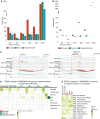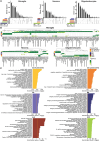Genetic risk for neurodegenerative conditions is linked to disease-specific microglial pathways
- PMID: 40202986
- PMCID: PMC12017514
- DOI: 10.1371/journal.pgen.1011407
Genetic risk for neurodegenerative conditions is linked to disease-specific microglial pathways
Abstract
Genome-wide association studies have identified thousands of common variants associated with an increased risk of neurodegenerative disorders. However, the noncoding localization of these variants has made the assignment of target genes for brain cell types challenging. Genomic approaches that infer chromosomal 3D architecture can link noncoding risk variants and distal gene regulatory elements such as enhancers to gene promoters. By using enhancer-to-promoter interactome maps for human microglia, neurons, and oligodendrocytes, we identified cell-type-specific enrichment of genetic heritability for brain disorders through stratified linkage disequilibrium score regression. Our analysis suggests that genetic heritability for multiple neurodegenerative disorders is enriched at microglial chromatin contact sites, while schizophrenia heritability is predominantly enriched at chromatin contact sites in neurons followed by oligodendrocytes. Through Hi-C coupled multimarker analysis of genomic annotation (H-MAGMA), we identified disease risk genes for Alzheimer's disease, Parkinson's disease, multiple sclerosis, amyotrophic lateral sclerosis and schizophrenia. We found that disease-risk genes were overrepresented in microglia compared to other brain cell types across neurodegenerative conditions and within neurons for schizophrenia. Notably, the microglial risk genes and pathways identified were largely specific to each disease. Our findings reinforce microglia as an important, genetically informed cell type for therapeutic interventions in neurodegenerative conditions and highlight potentially targetable disease-relevant pathways.
Copyright: © 2025 Askarova et al. This is an open access article distributed under the terms of the Creative Commons Attribution License, which permits unrestricted use, distribution, and reproduction in any medium, provided the original author and source are credited.
Conflict of interest statement
The authors have declared that no competing interests exist.
Figures



Similar articles
-
Genetic evidence for the liver-brain axis: lipid metabolism and neurodegenerative disease risk.Lipids Health Dis. 2025 Feb 8;24(1):41. doi: 10.1186/s12944-025-02455-3. Lipids Health Dis. 2025. PMID: 39923073 Free PMC article.
-
Heritability Enrichment Implicates Microglia in Parkinson's Disease Pathogenesis.Ann Neurol. 2021 May;89(5):942-951. doi: 10.1002/ana.26032. Epub 2021 Mar 4. Ann Neurol. 2021. PMID: 33502028 Free PMC article.
-
Common Factors in Neurodegeneration: A Meta-Study Revealing Shared Patterns on a Multi-Omics Scale.Cells. 2020 Dec 8;9(12):2642. doi: 10.3390/cells9122642. Cells. 2020. PMID: 33302607 Free PMC article.
-
Epigenetics in Neurodegenerative Diseases.Subcell Biochem. 2025;108:73-109. doi: 10.1007/978-3-031-75980-2_3. Subcell Biochem. 2025. PMID: 39820861 Review.
-
Microglia in Neurodegenerative Diseases.Adv Neurobiol. 2024;37:497-512. doi: 10.1007/978-3-031-55529-9_27. Adv Neurobiol. 2024. PMID: 39207709 Review.
References
MeSH terms
Substances
LinkOut - more resources
Full Text Sources
Medical

